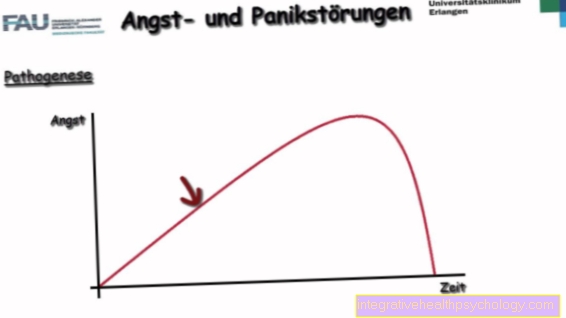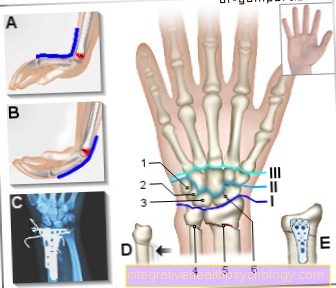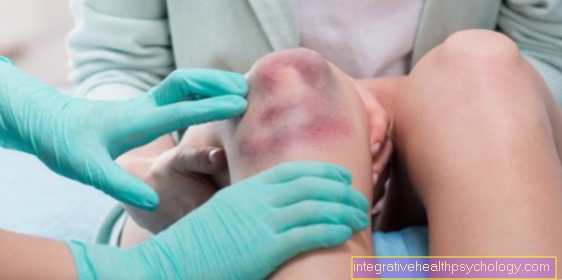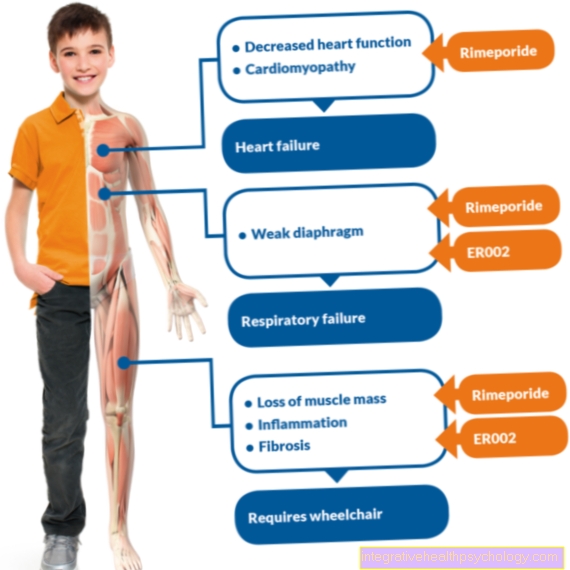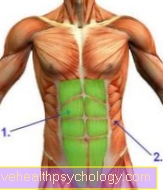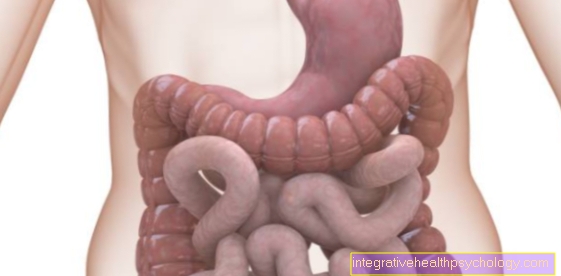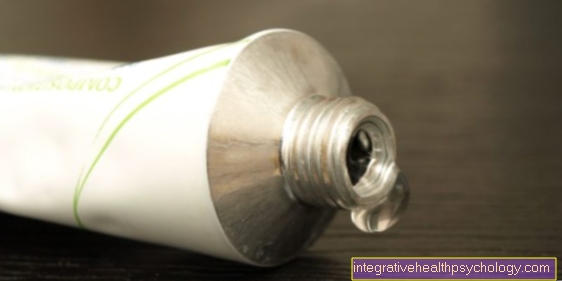Testicular hernia
introduction
A broken testicle is also known as a scrotal hernia. Despite the misleading name, it is not a rupture of the testicle, but a tear in the abdominal wall, through which part of the intestines sinks into the scrotum. A testicular hernia often develops from an advanced hernia. Children and men between the ages of 40 and 50 in particular often suffer a broken testicle. While smaller fractures are symptom-free and often go unnoticed, larger scrotal hernias in particular can be very painful and must be treated immediately.
Read more on the topic: Diseases of the testicles

causes
Most of the abdominal organs are located in the body within the peritoneum (peritoneum). This is a thin layer of tissue that lines the inside of the abdominal cavity and extends from the diaphragm to the small pelvis.
A tissue tear in the abdominal wall can create a gap through which the peritoneum is pushed out of the abdomen. This sack-like protuberance is called a hernial sac. The hernial sac consists of parts of the intestines (mainly the small intestine and the surrounding fatty tissue) that are covered by the peritoneum. Most often, the hernial portal forms in the groin (inguinal hernia). If the hernial sac is very heavy, it migrates further down the groin along the spermatic cord and can thus get into the testicles. This clinical picture is then referred to as a testicular hernia.
In most cases, the cause of a broken testicle is a weak connective tissue in the abdominal area. An inguinal hernia forms through the gaps or cracks in the abdominal wall, which can subsequently develop into a testicle hernia. However, not every testicular hernia results from a previous hernia.
In newborns in particular, a testicular fracture is often congenital and can be traced back to a developmental defect. The scrotal hernia often forms when the pressure in the abdomen increases sharply. This happens, for example, when lifting heavy objects: the pressure increases so much that the fabric can no longer withstand and tears.
But also strong coughing, excessive straining during bowel movements or certain types of sports can trigger a hernia.
Read more on the topic: Causes of an inguinal hernia
Concomitant symptoms
Small hernias in particular can often be symptom-free, whereas larger hernias are always accompanied by accompanying symptoms. Typically, the symptoms worsen when coughing, pressing or carrying heavy loads, as this increases the pressure in the abdomen.
Depending on the size of the hernia, the following symptoms can occur:
- visible enlargement of the scrotum
- Sensitivity to pressure and tension.
- nausea
- Vomit
- Stool irregularities such as constipation or diarrhea
Scrotal hernias also cause stools to contain blood. The men affected feel sick and exhausted. A testicular hernia becomes problematic when part of the intestines is constricted by the hernia and thereby cut off from the blood supply. In such cases, you suddenly experience very severe pain, as well as nausea and vomiting. A pinched fracture (incarceration) is an absolute emergency that requires immediate surgery.
Read more on the topic: Swollen testicle - what's behind it?
diagnosis
If a testicle hernia is suspected, the affected men should consult a urologist. Doctors make the diagnosis of testicular hernia by doing a physical exam by palpating the groin and testicles. He can determine whether parts of the intestine in the testicle can be felt and whether the hernial sac can be pushed back into the groin.
To rule out rectal cancer, the doctor also carries out a digital rectal examination in which the rectum is scanned with a finger via the anus. In most cases, an ultrasound examination of the abdomen is also carried out. Through this examination, the doctor can determine the size of the hernial opening in the abdominal wall and whether abdominal organs are trapped.
Pain
If the testicle breaks, the affected men suffer from more or less severe pain. However, not everyone experiences pain. The pain is described as pulling, burning, stabbing or dull and can be felt primarily in the affected testicles and groin. Sometimes the patients just feel an uncomfortable pulling in the lower abdomen, which can radiate into the environment. Extreme abdominal pain combined with nausea and vomiting can be signs of a pinched hernia that needs treatment immediately.
Read more on the topic: Testicular pain
What is the difference to a waterfall?
A water break (hydrocele) is an accumulation of fluid in the testicle. As with a broken testicle, a water break results in a significant enlargement of the scrotum. However, in contrast to a testicular hernia, there are no viscera from the abdomen into the testicles, rather fluid collects in the testicles. Frequent causes of a water break are inflammation of the testicles, tumor diseases or trauma (e.g. kick in the testicles).
Congenital hydroceles also sometimes appear in male newborns. During development, the connection between the abdominal cavity and scrotum does not close completely - as is normally the case. As a result, water from the abdomen can collect in the scrotum. A water break usually causes no pain. The therapy consists of a small operation in which the existing connection between the abdomen and testicles is broken.
Read more on the topic: Hydrocele
What is the difference to an inguinal hernia?
A testicular hernia can often develop from an advanced hernia (inguinal hernia or inguinal hernia), but the two types of hernia differ from one another. In the case of an inguinal hernia, the hernial port lies in the inguinal canal and those affected notice an indentable bump in the inguinal area. The hernial sac hangs over the inguinal ligament, whereas in the testicular hernia it migrates through the inguinal canal to the testes.
Read more on the topic: Inguinal hernia
What are the possible consequences?
Usually, a hernia can be operated on without any problems and then heals without any problems. A testicular hernia that is not treated or not treated properly can also lead to unpleasant long-term consequences. In some cases, nerves or blood vessels are pinched by the hernial sac. As a result, there may be a reduced blood flow to the bowel.
Since the intestine is an extremely sensitive organ, the lack of oxygen supply can cause intestinal sections to die off quickly.
This clinical picture is called intestinal ischemia. Acute bowel ischemia causes severe symptoms such as excruciating abdominal pain, bloody stools, vomiting, and nausea. Bowel ischemia is a medical emergency and requires prompt treatment in the form of surgery. When large parts of the intestine die, the disease progresses poorly and the majority of patients die. Other consequences of a scrotal hernia can be impotence and infertility.
Can a broken testicle make you sterile?
In some cases, important structures within the groin, such as the testicular artery or the spermatic cord, are pinched off when the testicle is broken. The spermatic cord contains the nerves and vessels that supply the testicles. In addition, the spermatic duct runs in the spermatic cord. With a clamp, the testicle on the affected side can no longer be properly supplied with blood.
If this condition persists for a long time (more than six to seven hours) the testicles can be permanently damaged and the man becomes sterile. On the other hand, if the testicle is not damaged, fertility is retained.
Can a hernia testicle make you impotent?
In the case of complicated testicular fractures, the spermatic cord in the inguinal canal may be pinched off. Important nerves and vessels run in the spermatic cord that ensure that men can get an erection. If these structures are clamped off over a long period of several hours, this can lead to permanent impotence. For this reason, a doctor should be consulted immediately if a testicle hernia is suspected.
How is a testicular hernia operated?
A testicular hernia is treated surgically. The hernia operation is also known as a herniotomy. The aim of the operation is to move the hernial sac together with the intestines back into the abdomen and then to close the hernial opening in the abdominal wall. There are different methods of operating a scrotal hernia, depending on the size of the break and the general condition of the patient. A fundamental distinction is made between an open operation and a laparoscopic procedure (keyhole surgery).
During the operation, the surgeon first tries to depict the hernial sac and hernial port through a small incision on the abdominal wall in order to have as precise an overview as possible of the hernia. Then the hernial sac is repositioned, which means it is moved back into the abdomen. If a section of the intestine has already been pinched by the break and has been damaged by the reduced blood flow, this section of the intestine must be cut out.
The fracture gap is then closed. In most cases, the closure is reinforced by a plastic mesh that is placed behind the spermatic cord. Finally, the layers of the abdominal wall are sutured and the wound is masked sterile.
There is also the option of performing the entire operation endoscopically using a minimally invasive, laparoscopic technique. The abdominal cavity is not completely cut open, but special devices are introduced through small incisions. Using an endoscope, the surgeon can display the abdomen on a monitor.The hernial sac is repositioned using special instruments and the hernial gap is covered with a mesh.
Duration of the operation
How long an operation lasts for a broken testicle depends on the surgical method chosen. The procedure usually takes between 45 minutes and an hour. If complications arise during the operation, the duration of the operation is extended accordingly.
Risks of the operation
Hernia operations are standard procedures that are performed routinely. Nevertheless, like any other surgical procedure, the operation also carries certain risks and unforeseen complications can occur. During the operation, nerves or blood vessels in the area of the hernia may be damaged. The spermatic cord can also be injured. In the worst case, the testicles are no longer adequately supplied and testicular atrophy (testicular shrinkage) occurs. The testicles atrophy and lose their function, which means that neither sperm nor hormones can be produced in sufficient quantities.
Wound healing disorders can occur after the operation, which means that the wound takes a long time to heal completely. The wound can also become infected and become infected. The risk of rebleeding cannot be ruled out either. Some patients tend to have excessive scarring, which creates too much connective tissue and makes the scar appear very bulging. In addition, even after a successful operation, there is a risk that the operated area will break again.
Hernia surgery is usually relatively low-risk and very rarely has serious complications. Before the operation, the treating surgeon and the anesthetist provide the patient with detailed information about the operation and possible risks.
What are the alternatives?
In general, surgery is the treatment of first choice for a broken testicle. However, if the patient does not want an operation or if this is not possible for other reasons (e.g. old fractures or high risk of surgery), there are alternative options.
In the case of smaller fractures, the doctor can try to push the hernial sac back manually. Another alternative to surgery is treating the hernia with a so-called hernial ligament. This is a kind of belt with a wooden fixing plate that prevents the hernial sac from sliding down any further. These alternative methods are not an option, especially for large hernias, as the risk of incarceration (entrapment) of parts of the intestine is too great.
forecast
The prognosis for a testicular hernia is usually good. However, depending on the surgical method, a new fracture may occur. The recurrence rate is 2-10%. Strengthening the abdominal and back muscles through exercise can help prevent a testicular hernia. Even after the operation, the abdominal wall must not be excessively stressed. The patient has to take it easy for several months, i.e. he is not allowed to carry heavy things and has to avoid certain sports.
Broken testicle in baby
Babies are very often affected by a broken testicle and around 5% of male babies are born with a congenital scrotal hernia. In premature babies in particular, a testicular fracture often forms due to an incomplete abdominal wall obstruction. The connection between the abdomen and testicles remains intact in the fetus. Through this connection, the testes descend from the abdominal cavity into the scrotum during embryonic development.
After this process, the corridor usually closes. If it remains open, organs from the abdomen, very often the small intestine, can slide into this protuberance and cause a testicle hernia. Another cause of a sudden testicular hernia is testicular torsion. The testicles wrap around their own stalk and a broken testicle can occur. Babies and toddlers are very often affected by this twisting of the testicles, as the testicular cover is not yet sufficiently fused with the surrounding tissue.
Parents notice the hernia from a swelling on the child's scrotum, which can also cause the testicle to turn blue. If parents notice abnormalities that indicate a broken testicle, they should see a pediatrician as soon as possible. As with adults, there is a risk that parts of the intestine or internal organs can be pinched off by the hernial sac and thus no longer be adequately supplied with blood and oxygen.


